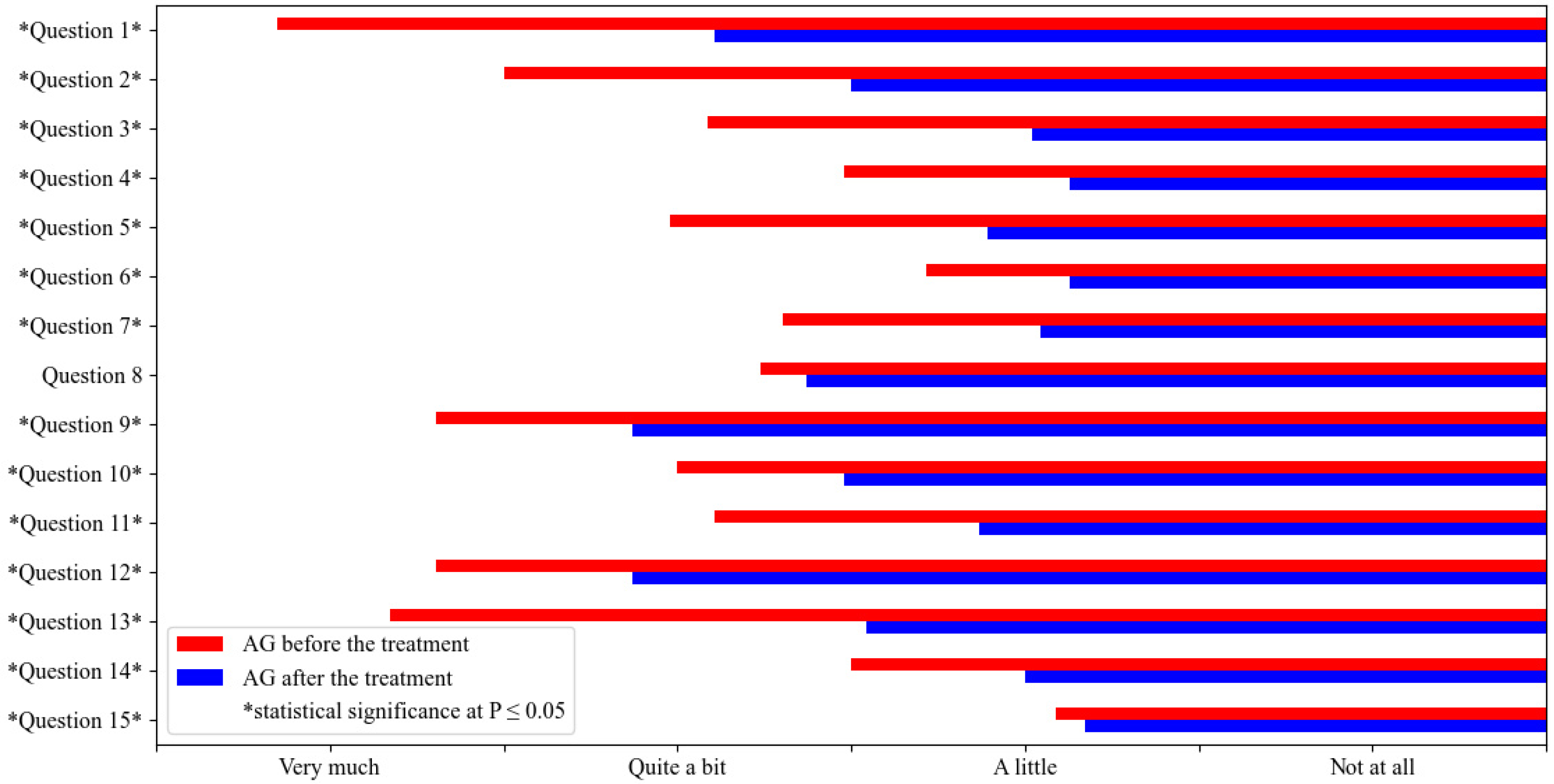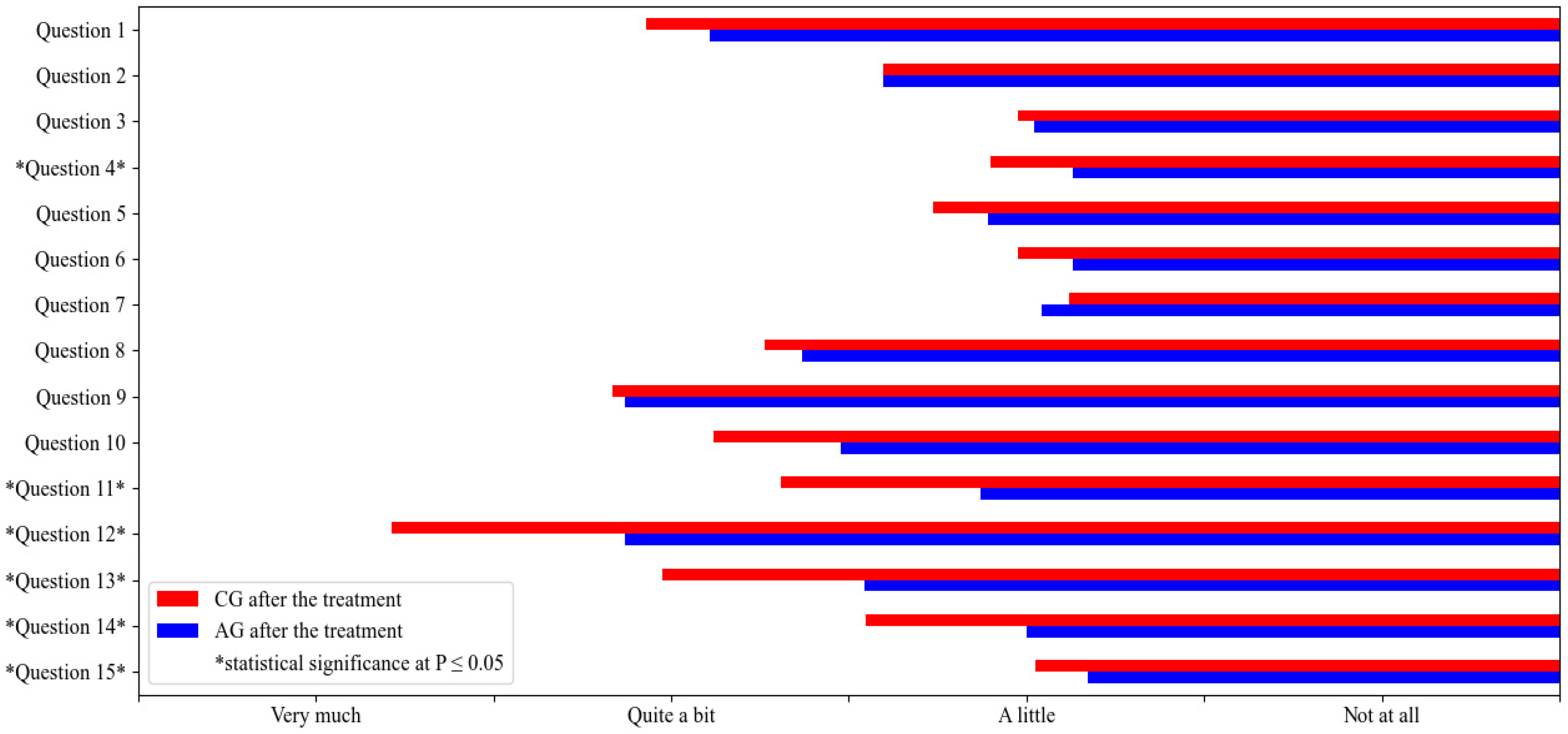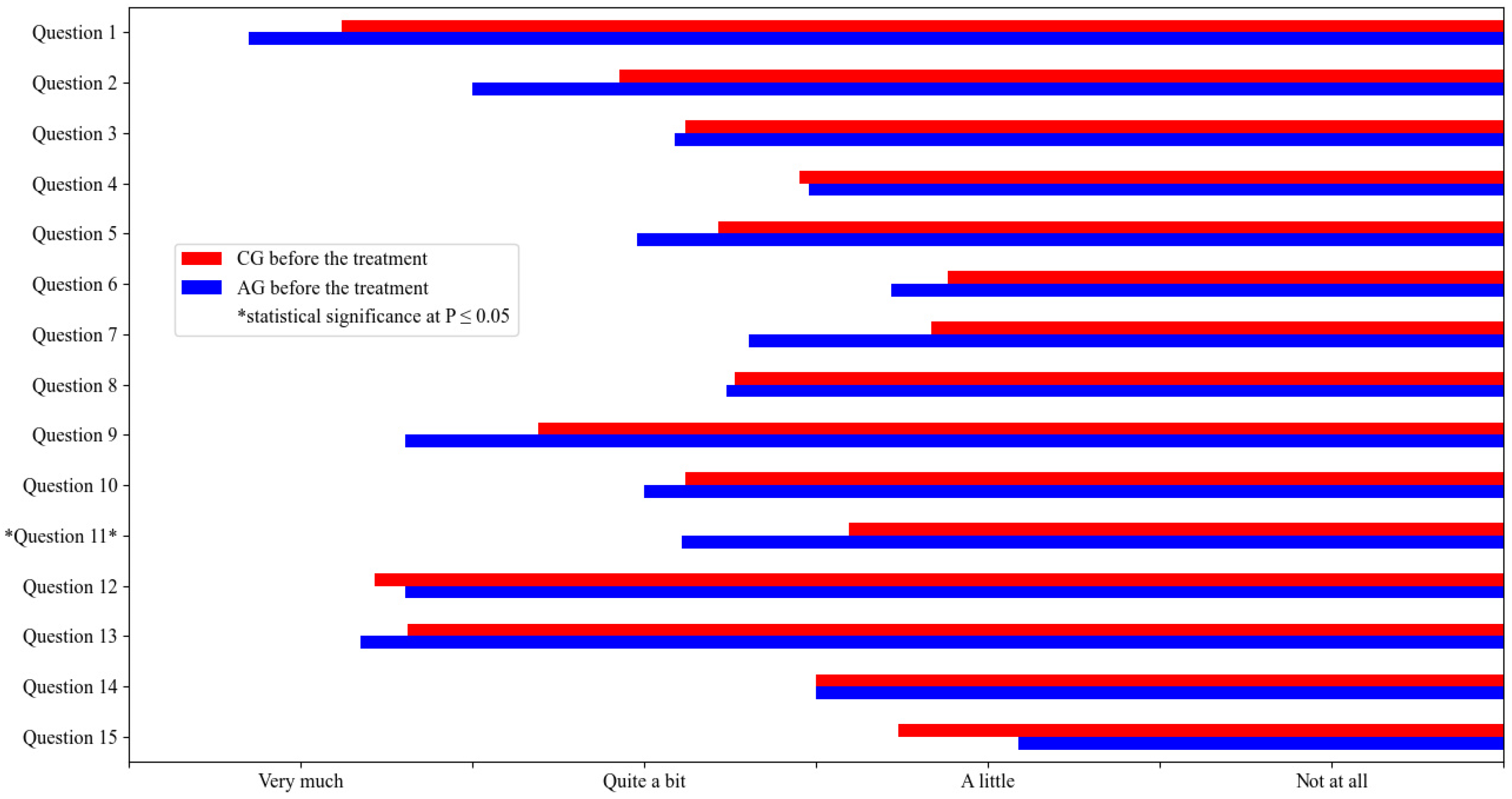Quality of Life of Allergic Dogs Treated with Allergen-Specific Immunotherapy—A Retrospective Study
Abstract
Simple Summary
Abstract
1. Introduction
2. Materials and Methods
3. Results
3.1. Included Animals
3.2. Epidemiology of ASIT Treatment
3.3. Quality-of-Life Questionnaires Results
4. Discussion
5. Limitations
6. Conclusions
Funding
Institutional Review Board Statement
Informed Consent Statement
Data Availability Statement
Acknowledgments
Conflicts of Interest
References
- Noli, C.; Minafo, G.; Galzerano, M. Quality of life of dogs with skin diseases and their owners. Part1: Development and validation of a questionnaire. Vet. Dermatol. 2011, 22, 335–343. [Google Scholar] [CrossRef] [PubMed]
- Noli, C.; Colombo, S.; Cornegliani, L.; Ghibaudo, G.; Persico, P.; Vercelli, A.; Galzerano, M. Quality of life of dogs with skin disease and of their owners. Part 2: Administration of a questionnaire in various skin diseases and correlation to efficacy of therapy. Vet. Dermatol. 2011, 22, 344–351. [Google Scholar] [CrossRef] [PubMed]
- Shenoda, Y.; Ward, M.P.; McKeegan, D.; Fawcett, A. “The Cone of Shame”: Welfare Implications of Elizabethan Collar Use on Dogs and Cats as Reported by their Owners. Animals 2020, 10, 333. [Google Scholar] [CrossRef]
- Yeates, J.; Main, D. Assessment of companion animal quality of life in veterinary practice and research. J. Small Anim. Pract. 2009, 50, 274–281. [Google Scholar] [CrossRef] [PubMed]
- Bono, G.; De Mori, B. Animals and their quality of life: Considerations ‘beyond mere welfare’. Vet. Res. Commun. 2005, 29 (Suppl. 2), 165–168. [Google Scholar] [CrossRef] [PubMed]
- Halliwell, R. Revised nomenclature for veterinary allergy. Vet. Immunol. Immunopathol. 2006, 114, 207–208. [Google Scholar] [CrossRef]
- Olivry, T.; DeBoer, D.J.; Favrot, C.; Jackson, H.A.; Mueller, R.S.; Nuttall, T.; Prélaud, P.; International Committee on Allergic Diseases of Animals. Treatment of canine atopic dermatitis: 2015 updated guidelines from the International Committee on Allergic Diseases of Animals (ICADA). BMC Vet. Res. 2015, 11, 210. [Google Scholar] [CrossRef]
- Cosgrove, S.B.; Wren, J.A.; Cleaver, D.M.; Walsh, K.F.; Follis, S.I.; King, V.I.; Jezaniah-Kira, T.S.; Stegemann, M.R. A blinded, randomized, placebo-controlled trial of the efficacy and safety of the Janus kinase inhibitor oclacitinib (Apoquel) in client-owned dogs with atopic dermatitis. Vet. Dermatol. 2013, 24, 587-e142. [Google Scholar] [CrossRef]
- Souza, C.P.; Rosychuk, R.A.W.; Contreras, E.T.; Schissler, J.R.; Simpson, A.C. A retrospective analysis of the use of lokivetmab in the management of allergic pruritus in a referral population of 135 dogs in the western USA. Vet. Dermatol. 2018, 29, 489-e164. [Google Scholar] [CrossRef]
- Olivry, T. ACVD task force on canine atopic dermatitis. Vet. Immunol. Immunopathol. 2001, 81, 143–385. [Google Scholar] [CrossRef]
- DeBoer, D.J. The future of immunotherapy for canine atopic dermatitis: A review. Vet. Dermatol. 2017, 28, 25-e6. [Google Scholar] [CrossRef] [PubMed]
- Fennis, E.E.M.; VanDamme, C.M.M.; Schlotter, Y.M.; Sinke, J.D.; Leistra, M.H.G.; Bartels, R.T.; Broere, F. Efficacy of subcutaneous allergen immunotherapy in atopic dogs: A retrospective study of 664 cases. Vet. Dermatol. 2022, 33, 321-e75. [Google Scholar] [CrossRef] [PubMed]
- Hensel, P.; Santoro, D.; Favrot, C.; Hill, P.; Griffin, C. Canine atopic dermatitis: Detailed guidelines for diagnosis and allergen identification. BMC Vet. Res. 2015, 11, 196. [Google Scholar] [CrossRef] [PubMed]
- Lauber, B.; Molitor, V.; Meury, S.; Doherra, M.G.; Favrot, C.; Tengvall, K.; Bergvall, K.; Leeb, T.; Roosje, P.; Marti, E. Total IgE and allergen-specific IgE and IgG antibody levels in sera of atopic dermatitis affected and non-affected Labrador- and Golden retrievers. Vet. Immunol. Immunopathol. 2012, 149, 112–118. [Google Scholar] [CrossRef]
- Mueller, R.S.; Bettenay, S.V. Long-term immunotherapy of 146 dogs with atopic dermatitis–a retrospective study. Aust. Vet. Pract. 1996, 26, 128–132. [Google Scholar]
- Zur, G.; White, S.D.; Ihrke, P.J.; Kass, P.H.; Toebe, N. Canine atopic dermatitis: A retrospective study of 169 cases examined at the University of California, Davis, 1992–1998. Part II. Response to hyposensitization. Vet. Dermatol. 2002, 13, 103–111. [Google Scholar] [CrossRef]
- Schnabl, B.; Bettenay, S.V.; Dow, K.; Mueller, R.S. Results of allergen-specific immunotherapy in 117 dogs with atopic dermatitis. Vet. Rec. 2006, 158, 81–85. [Google Scholar] [CrossRef] [PubMed]
- Tham, H.L.; Olivry, T. Determination of the efficacy rate and time-to-efficacy of subcutaneous immunotherapy in dogs with atopic dermatitis. Vet. Dermatol. 2021, 33, 155-e44. [Google Scholar] [CrossRef]
- Willemse, A.; Van den Brom, W.E.; Rijnberk, A. Effect of hyposensitization on atopic dermatitis in dogs. J. Am. Vet. Med. Assoc. 1984, 184, 1277–1280. [Google Scholar]
- Willemse, T.; Bardagi, M.; Carlotti, D.N.; Ferrer, L.; Fondati, A.; Fontaine, J.; Leistra, M.; Noli, C.; Ordeix, L.; Scarampella, F.; et al. Dermatophagoides farinae-specific immunotherapy in atopic dogs with hypersensitivity to multiple allergens: A randomised, double blind, placebo-controlled study. Vet. J. 2009, 180, 337–342. [Google Scholar] [CrossRef]
- Nuttall, T.J.; Thoday, K.L.; Van den Broek, A.H.; Jackson, H.A.; Sture, G.H.; Halliwell, R.E. Retrospective survey of allergen immunotherapy in canine atopy. Vet. Rec. 1998, 143, 139–142. [Google Scholar] [CrossRef] [PubMed]
- Park, S.; Ohya, F.; Yamashita, K.; Nishifuji, K.; Iwasaki, T. Comparison of response to immunotherapy by intradermal skin test and antigen-specific IgE in canine atopy. J. Vet. Med. Sci. 2000, 62, 983–988. [Google Scholar] [CrossRef] [PubMed]
- Timm, K.; Mueller, R.S.; Nett-Mettler, C.S. Long-term effects of intralymphatic immunotherapy (ILIT) on canine atopic dermatitis. Vet. Dermatol. 2018, 29, 123-e49. [Google Scholar] [CrossRef] [PubMed]
- Favrot, C.; Linek, M.; Mueller, R.S.; Zini, E.; International Task Force on Canine Atopic Dermatitis. Development of a questionnaire to assess the impact of atopic dermatitis on health-related quality of life of affected dogs and their owners. Vet. Dermatol. 2010, 21, 64–70. [Google Scholar] [CrossRef]
- DeBoer, D.J.; Verbrugge, M.; Morris, M. Clinical and immunological responses of dust mite sensitive, atopic dogs to treatment with sublingual immunotherapy (SLIT). Vet. Dermatol. 2016, 27, 82-e24. [Google Scholar] [CrossRef]
- Keppel, K.E.; Campbell, K.L.; Zuckermann, F.A.; Greeley, E.A.; Schaeffer, D.J.; Husmann, R.J. Quantitation of canine regulatory T cell populations, serum interleukin-10 and allergen-specific IgE concentrations in healthy control dogs and canine atopic dermatitis patients receiving allergen-specific immunotherapy. Vet. Immunol. Immunopathol. 2008, 123, 337–344. [Google Scholar] [CrossRef]
- Mueller, R.S.; Jensen-Jarolim, E.; Roth-Walter, F.; Marti, E.; Janda, J.; Seida, A.A.; DeBoer, D. Allergen Immunotherapy in People, Dogs, Cats and Horses—Differences, Similarities and Research Needs. Allergy 2018, 73, 1989–1999. Available online: https://onlinelibrary.wiley.com/doi/full/10.1111/all.13464 (accessed on 13 January 2019). [CrossRef]
- Shida, M.; Kadoya, M.; Park, S.J.; Nishifuji, K.; Momoi, Y.; Iwasaki, T. Allergen-specific immunotherapy induces Th1 shift in dogs with atopic dermatitis. Vet. Immunol. Immunopathol. 2004, 102, 19–31. [Google Scholar] [CrossRef]
- Plant, J.D.; Neradilek, M.B. Effectiveness of regionally-specific immunotherapy for the management of canine atopic dermatitis. BMC Vet. Res. 2016, 13, 4. [Google Scholar] [CrossRef]
- Elkholly, D.A.; Brodbelt, D.C.; Church, D.B.; Pelligand, L.; Mwacalimba, K.; Wright, A.K.; O’Neill, D.G. Side Effects to Systemic Glucocorticoid Therapy in Dogs Under Primary Veterinary Care in the UK. Front. Vet. Sci. 2020, 7, 515. [Google Scholar] [CrossRef]
- Olivry, T.; Steffan, J.; Fisch, R.D.; Prelaud, P.; Guaguere, E.; Fontaine, J.; Carlotti, D.N. Randomized controlled trial of the efficacy of cyclosporine in the treatment of atopic dermatitis in dogs. J. Am. Vet. Med. Assoc. 2002, 221, 370–377. [Google Scholar] [CrossRef] [PubMed]




| No. | Question | B Mean ± St.dev. | A Mean ± St.dev | p Value |
|---|---|---|---|---|
| 1. | Severity of disease | 3.381 ± 0.722 | 2.571 ± 0.583 | Student 0.0000001 |
| 2. | Behaviour/mood influence | 2.571 ± 1.003 | 1.905 ± 0.683 | Wilcox 0.0002 |
| 3. | Sleep disruption | 2.381 ± 1.045 | 1.524 ± 0.732 | Wilcox 0.0003 |
| 4. | Meals disruption | 2.05 ± 1.071 | 1.6 0.735 | Wilcox 0.003 |
| 5. | Playing/working disruption | 2.286 ± 0.933 | 1.762 ± 0.75 | Student 0.0002 |
| 6. | Social relationship disruption | 1.619 ± 0.785 | 1.524 ± 0.732 | Wilcox 0.157 |
| 7. | Change of habits | 1.667 ± 0.836 | 1.381 ± 0.575 | Wilcox 0.014 |
| 8. | Therapies | 2.238 ± 1.109 | 2.238 ± 0.868 | Student 1.0 |
| 9. | Time loss | 2.81 ± 0.906 | 2.667 ± 1.039 | Student 0.19 |
| 10. | Physical exhaustion | 2.381 ± 0.898 | 2.381 ± 1.045 | Student 1.0 |
| 11. | Family activities disruption | 1.905 ± 0.921 | 2.190 ± 1.096 | Student 0.01 |
| 12. | Expenditure influence | 3.286 ± 0.825 | 3.286 ± 0.765 | Wilcox 1.0 |
| 13. | Emotional distress | 3.19 ± 0.794 | 2.524 ± 1.052 | Wilcox 0.0005 |
| 14. | Physical uneasiness | 2.0 ± 0.926 | 1.952 ± 0.898 | Student 0.329 |
| 15. | Family relationship influence | 1.762 ± 0.971 | 1.476 ± 0.732 | Wilcox 0.0339 |
| No. | Question | B Mean ± St.dev. | A ± Mean ± St.dev | p Value |
|---|---|---|---|---|
| 1. | Severity of disease | 3.652 ± 0.633 | 2.391 ± 0.966 | Student < 0.0000001 |
| 2. | Behaviour/mood influence | 3.000 ± 0.834 | 2.000 ± 0.834 | Wilcox < 0.0000001 |
| 3. | Sleep disruption | 2.413 ± 0.946 | 1.478 ± 0.827 | Wilcox < 0.0000001 |
| 4. | Meals disruption | 2.022 ± 1.053 | 1.370 ± 0.703 | Wilcox 0.000006 |
| 5. | Playing/working disruption | 2.522 ± 0.926 | 1.609 ± 0.82 | Student < 0.0000001 |
| 6. | Social relationship disruption | 1.783 ± 0.930 | 1.370 ± 0.733 | Wilcox 0.000013 |
| 7. | Change of habits | 2.196 ± 1.055 | 1.457 ± 0.877 | Wilcox 0.0000008 |
| 8. | Therapies | 2.261 ± 0.895 | 2.130 ± 1.013 | Student 0.06 |
| 9. | Time loss | 3.196 ± 0.797 | 2.630 ± 0.941 | Student < 0.0000001 |
| 10. | Physical exhaustion | 2.500 ± 0.853 | 2.022 ± 0.944 | Student < 0.0000001 |
| 11. | Family activities disruption | 2.391 ± 0.872 | 1.630 ± 0.817 | Wilcox < 0.0000001 |
| 12. | Expenditure influence | 3.196 ± 0.924 | 2.630 ± 0.941 | Student < 0.0000001 |
| 13. | Emotional distress | 3.326 ± 0.886 | 1.957 ± 0.908 | Student < 0.0000001 |
| 14. | Physical uneasiness | 2.000 ± 1.083 | 1.500 ± 0.828 | Wilcox 0.00001 |
| 15. | Family relationship influence | 1.413 ± 0.768 | 1.326 ± 0.753 | Wilcox 0.0455 |
Disclaimer/Publisher’s Note: The statements, opinions and data contained in all publications are solely those of the individual author(s) and contributor(s) and not of MDPI and/or the editor(s). MDPI and/or the editor(s) disclaim responsibility for any injury to people or property resulting from any ideas, methods, instructions or products referred to in the content. |
© 2023 by the author. Licensee MDPI, Basel, Switzerland. This article is an open access article distributed under the terms and conditions of the Creative Commons Attribution (CC BY) license (https://creativecommons.org/licenses/by/4.0/).
Share and Cite
Kotnik, T. Quality of Life of Allergic Dogs Treated with Allergen-Specific Immunotherapy—A Retrospective Study. Vet. Sci. 2023, 10, 72. https://doi.org/10.3390/vetsci10020072
Kotnik T. Quality of Life of Allergic Dogs Treated with Allergen-Specific Immunotherapy—A Retrospective Study. Veterinary Sciences. 2023; 10(2):72. https://doi.org/10.3390/vetsci10020072
Chicago/Turabian StyleKotnik, Tina. 2023. "Quality of Life of Allergic Dogs Treated with Allergen-Specific Immunotherapy—A Retrospective Study" Veterinary Sciences 10, no. 2: 72. https://doi.org/10.3390/vetsci10020072
APA StyleKotnik, T. (2023). Quality of Life of Allergic Dogs Treated with Allergen-Specific Immunotherapy—A Retrospective Study. Veterinary Sciences, 10(2), 72. https://doi.org/10.3390/vetsci10020072






